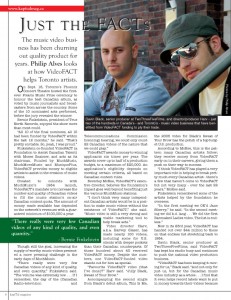Just the FACTs
The music video business has been churning out quality product for years. Philip Alves looks at how VideoFACT helps Toronto artists.
On Sept. 18, Toronto’s Phoenix Concert Theatre hosted the first-ever Polaris Music Prize ceremony to honour the best Canadian album, as voted by music journalists and broadcasters from across the country. Some of the 10 nominated acts performed, before the jury revealed the winner.
Bernie Finkelstein, president of True North Records, enjoyed the show more than most could.
“All 10 of the final nominees, all 10 had been funded by VideoFACT within the last 12 months,” he said. “That’s pretty enviable. So, yeah, I was proud.”
Finkelstein co-founded VideoFACT (a Foundation to Assist Canadian Talent) with Moses Znaimer, and acts as its chairman. Funded by MuchMusic, MuchMoreMusic and MusiquePlus, VideoFACT provides money to eligible artists to assist in the creation of music videos.
Created to coincide with MuchMusic’s 1984 launch, VideoFACT’s mandate is to increase the number and quality of Canadian videos to fill the music station’s on-air Canadian content quota. The amount of money made available has depended on the network’s revenues with a guaranteed minimum of $100,000 a year.
Though still the goal, increasing the supply of worthy music videos presented a more pressing challenge in the early days of MuchMusic.
“There really were very few Canadian videos of any kind of quality, and even quantity,” Finkelstein said. “The volume was extremely low … If I remember, the day of the (Canadian Radio-television and Telecommunications Commission licencing) hearing, we could only count 22 Canadian videos of the nature that we could play.”
VideoFACT awards money to winning applicants six times per year. The awards cover up to half of a production budget, to a maximum of $20,000. An application’s eligibility depends on meeting certain criteria, all based on Canadian content rules.
Beverley McKee, VideoFACT’s executive director, believes the foundation’s impact goes well beyond benefiting just the various MuchMusic stations.
“I don’t think very many independent Canadian artists would be in a position to make music videos without the existence of VideoFACT,” she said. “Music video is still a very strong and viable marketing tool to help break acts.”
Video director Harv, a.k.a. Harvey Glazer, has made nearly 100 videos, including some for U.S. clients with deeper pockets than their Canadian counterparts. Of those hundred about 40 received VideoFACT money. Despite the numbers, one VideoFACT-funded video stands out for him as special.
“Favourite VideoFACT video (that I’ve done)?” Harv said. “Jully Black, ‘Sweat Of Your Brow’.”
Accompanying the second single from Black’s debut album, This Is Me, the 2005 video for Black’s ‘Sweat Of Your Brow’ has the polish of a big-budget U.S. production.
According to McKee, this is the pattern many Canadian artists follow; they receive money from VideoFACT early on in their careers, giving them a push on their way to success.
“I think VideoFACT has played a very important role in helping to break pretty much every Canadian artist – there’s a few that haven’t come to VideoFACT but not very many – over the last 22 years,” McKee said.
Finkelstein remembered some of the artists helped by the foundation he oversees.
“In the first meeting we OK’d Jane Siberry,” he said. “In the second meeting we did k.d. lang … We did the first Barenaked Ladies video. The list is endless.”
Now in its 23rd year, VideoFACT has handed out over $44 million to those on that endless list stretching back to 1984.
Davin Black, senior producer at TwoThreeFiveFilms, said VideoFACT has kept his studio busy and continues to push the national video production business.
“VideoFACT has been keeping it moving for us,” Black said. “And not only for just us, but for the Canadian music video industry as a whole … I find that it even helps record labels want to put in money towards their videos because they’re getting some support.”
More than influencing labels to spend their marketing dollars, McKee said VideoFACT convinces them to pump more money into video production.
“If a company like VideoFACT is putting money into music video production,” she said, “it allows labels, who have artists that are eligible for VideoFACT on their roster, to put the money that otherwise might have been spent on music videos into other marketing initiatives.”
McKee also admitted to feeling proud when a director of a VideoFACT video gains success.
“It’s really exciting to see directors and musicians go from nobodies to huge stars,” she said. “I think that VideoFACT is something that a lot of very successful directors look back on as giving them an opportunity to cut their teeth.”
With his first feature film, Kickin It Old Skool, set for release in 2007, and nearly 40 VideoFACT videos to his credit, Harv is a prime example of that success.
And the difference between shooting a music video and a feature film?
“It’s the time,” Harv said. “Instead of shooting for one really long day, you’re shooting for 25 really long days. It’s definitely like an epic mission to get through it.”
kapiTal Magazine December, 2006 Page: 6 Byline: Philip Alves www.kapitalmag.ca
